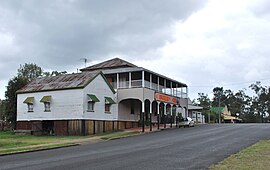
Esk is a town and locality in the Somerset Region in South East Queensland, Australia. In the 2016 census, Esk had a population of 1,698 people.

Toogoolawah is a rural town and locality in the Somerset Region, Queensland, Australia. In the 2016 census, Toogoolawah had a population of 1,279 people.
Mooloolah Valley is a rural locality in the Sunshine Coast Region, Queensland, Australia. In the 2016 census, Mooloolah Valley had a population of 3,321 people.

Landsborough is a town and a locality in the Sunshine Coast Region, Queensland, Australia. At the 2021 census, Landsborough had a population of 4,446 people.
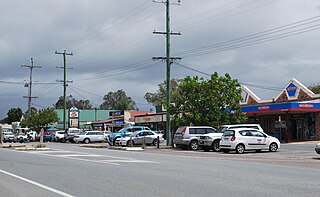
Woodford is a rural town and locality in the Moreton Bay Region, Queensland, Australia. In the 2016 census, the locality of Woodford had a population of 3,458 people.

Enoggera is a suburb in the City of Brisbane, Queensland, Australia. In the 2016 census, Enoggera had a population of 5,157 people.
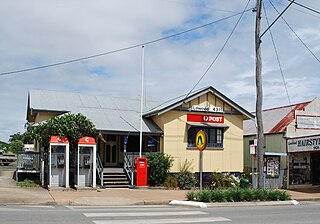
Lowood is a rural town and locality in the Somerset Region, Queensland, Australia. In the 2016 census, the locality of Lowood had a population of 4,159 people.
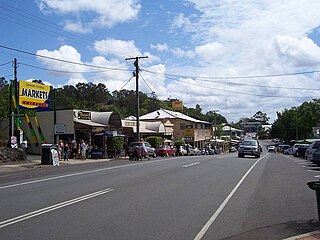
Eumundi is a rural town and locality in the Sunshine Coast Region, Queensland, Australia. In the 2016 census, the locality of Eumundi had a population of 2,221 people.

Coominya is a town and locality in the Somerset Region in South East Queensland, Australia. The town is located 83 kilometres (52 mi) west of the state capital, Brisbane and approximately 2 kilometres (1.2 mi) from Wivenhoe Dam. In the 2016 census, Coominya had a population of 1,200 people.

Howard is a rural town and locality in the Fraser Coast Region, Queensland, Australia. In the 2016 census, Howard had a population of 1,359 people. It is located 284 kilometres (176 mi) north of Brisbane and 37 kilometres (23 mi) west of Hervey Bay.
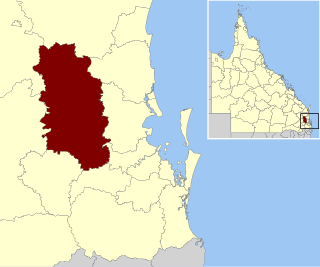
The Somerset Region is a local government area located in the West Moreton region of South East Queensland, Australia, about 100 kilometres (62 mi) northwest of Brisbane and centred on the town of Esk. It was created in 2008 from a merger of the Shire of Esk and the Shire of Kilcoy. It is commonly known as the Brisbane Valley, due to the Brisbane River which courses through the region, although significant parts of the region lie outside the hydrological Brisbane Valley itself.

The Brisbane Valley railway line was a railway connection in Queensland, Australia connecting Ipswich, west of Brisbane, to the upper Brisbane River valley. Progressively opened between 1884 and 1913 the railway provided a vital transport link between Ipswich and Yarraman and forged development and prosperity along its path. The line acquired its serpentine reputation because it did not take a straight course when faced with a hill or gully.

Moore is a rural town and locality in the Somerset Region, Queensland, Australia. In the 2016 census, the locality of Moore had a population of 296 people.

Benarkin is a rural town and locality in the South Burnett Region, Queensland, Australia. The nearby town of Blackbutt is the origin of the town and the two towns are often referred to as the joint entity Blackbutt-Benarkin. In the 2016 census, Benarkin had a population of 61 people.
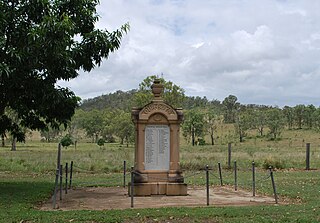
Colinton is a rural locality in the Somerset Region, Queensland, Australia. In the 2016 census, Colinton had a population of 75 people.
Cressbrook is a rural locality in the Somerset Region, Queensland, Australia. In the 2016 census Cressbrook had a population of 117 people.
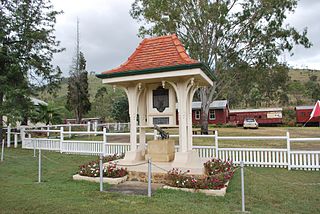
Linville War Memorial is a heritage-listed memorial at George Street, Linville, Somerset Region, Queensland, Australia. It was designed by Tom Cross and built in 1921 by his brothers Frank and Jim Cross. The Memorial was unveiled on 1 August 1922 with Mr A Smith presiding. It was added to the Queensland Heritage Register on 11 December 2008.
Mount Stanley is a rural locality in the Somerset Region, Queensland, Australia. In the 2016 census Mount Stanley had a population of 7 people.

Colinton War Memorial is a heritage-listed war memorial at the corner of the D'Aguilar Highway and Emu Creek Road, Colinton, Somerset Region, Queensland, Australia. It was built in 1917. It was added to the Queensland Heritage Register on 15 July 2016.

Biarra is a rural locality in the Somerset Region, Queensland, Australia. In the 2016 census, Biarra had a population of 257 people.
